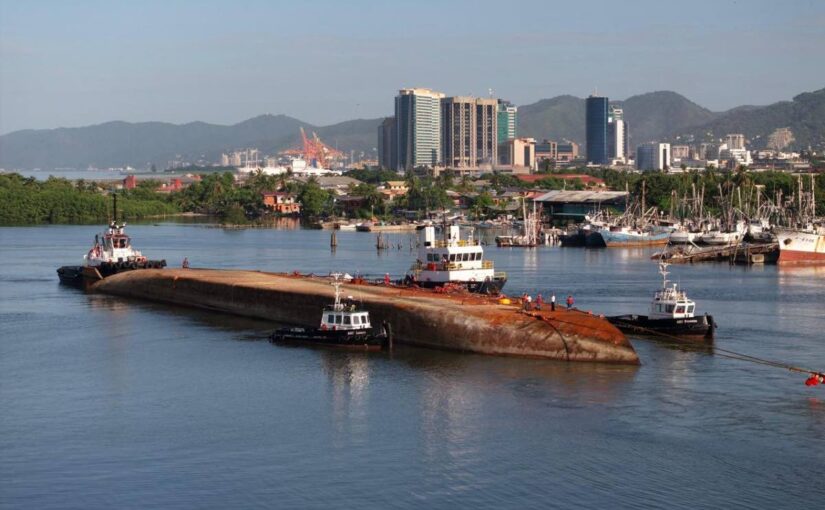The history of the Caspian Sea Oil Fleet coincides with the establishment of offshore oil extraction in Azerbaijan. When the fleet was founded in...
Vous n'êtes pas connecté
- English
- Français
- عربي
- Español
- Deutsch
- Português
- русский язык
- Català
- Italiano
- Nederlands, Vlaams
- Norsk
- فارسی
- বাংলা
- اردو
- Azərbaycan dili
- Bahasa Indonesia
- Հայերեն
- Ελληνικά
- Bosanski jezik
- українська мова
- Íslenska
- Türkmen, Түркмен
- Türkçe
- Shqip
- Eesti keel
- magyar
- Қазақ тілі
- Kalaallisut ; kalaallit oqaasii
- Lietuvių kalba
- Latviešu valoda
- македонски јазик
- Монгол
- Bahasa Melayu ; بهاس ملايو
- ဗမာစာ
- Slovenščina
- тоҷикӣ ; toğikī ; تاجیکی
- ไทย
- O'zbek ; Ўзбек ; أۇزبېك
- Tiếng Việt
- ភាសាខ្មែរ
- རྫོང་ཁ
- Soomaaliga ; af Soomaali
Rubriques :
 Maroc - RAWSTORY.COM - Raw Story - 06/Sep 10:45
Maroc - RAWSTORY.COM - Raw Story - 06/Sep 10:45
Serbia tackles sunken Nazi fleet in the Danube
A Serbian operation to clear a fleet of sunken Nazi warships from the Danube will bring relief to vessels struggling to navigate the waters, even if local fishermen will lose out.But the munitions buried underwater with the scuttled vessels mean they cannot be left there to rust indefinitely.For decades, the wrecks have been a reliable spot for fishermen to reel in their daily catch along this stretch of the river in eastern Serbia."Every year, they become visible when the water level of the Danube is low, especially when it drops extremely like this," fisherman Igor Skundric told AFP, surveying the waters from his wooden boat.Skundric has used the dozens of sunken warships to place traps to catch catfish and carp nestled amid the rusting vessels, near the Serbian village of Prahovo."There is a high concentration of fish, so it's much easier for us to get a catch," he said.The massive recovery operation will soon change that.But pulling the rusting hulks from the river will bring much-needed relief to local shipping.The spot has long frustrated navigators plying the Danube in the summer months, when water levels drop and passage through the channel narrows.During AFP's visit to the area, reporters saw two cargo boats that had run aground after trying to avoid the sunken vessels."Captains must be extremely cautious and incidents such as grounding frequently occur," Damir Vladic, the manager of the port of Prahovo, told AFP."It only takes a slight deviation from the navigable route to cause problems."- The river war -Nazi Germany and its allies occupied the Western Balkans from 1941 to 1945, where they imposed an iron-fisted rule and fought communist partisan guerillas.But following the disastrous invasion of the Soviet Union, German forces were steadily driven back to its borders.As Nazi troops retreated west, Germany scuttled scores of ships from its Black Sea Fleet across the Danube in September 1944.The aim was to slow the Red Army by clogging the river, but also to prevent the vessels from falling into Soviet hands."The Germans were retreating from the Red Army," said historian Velimir Miki Trailovic."They wanted to pass through the Djerdap Gorge," he added, referring to a nearby narrow river pass."But when they realized they couldn't, they decided to scuttle the ships."The Nazis sank nearly 200 vessels during their retreat, including transport ferries, barges, and torpedo boats, said Trailovic.For 80 years, the boats remained largely undisturbed on the bottom of the Danube. During droughts, the hulking steel hull of a German tugboat marked UJ-106 pierced the surface near Prahovo.A 2022 initiative financed by the European Investment Bank and Western Balkans Investment Framework has provided nearly 30 million euros to oversee the salvage operation to remove the crafts.- Mines and shells -Serbian officials estimate it will take a year and a half to remove the ships."In the coming months, we will retrieve 21 ships that have been lying on the bottom of the Danube," said Goran Vesic, Serbia's minister of construction, transportation and infrastructure.The first ship -- a minesweeper -- was pulled from the Danube in August. Local port workers even suggested the vessel could be relaunched after patching up its holes and extensive cleaning.But removing the ships is complicated by the submerged munitions buried with them, which require careful maneuvering to avoid any risk of detonating them."The ships are full of mines, shells, and unexploded ordnance, which could cause major, catastrophic problems if they were to explode," Trailovic told AFP."When divers came here a few years ago and saw what was there, we became aware of the great danger to Prahovo."But while ships' captains working the Danube will doubtless welcome the removal of the vessels, fishermen like Skundric will be sorry to see them go."They have had a very positive impact for us," Skundric told AFP.
Articles similaires
Discovering the Danube: A Luxurious River Cruise from Budapest Aboard Riviera’s ‘MS Emily Brontë’
ITTN’s Sharon Jordan continued on the second part of the Danube River Cruise, Europe’s second-longest river. Click here to read part one....
Powder Keg In The Pacific – Analysis
By Alfred W. McCoy While the world looks on with trepidation at regional wars in Israel and Ukraine, a far more dangerous global crisis is...
WA’s Back of Boat sales are booming, but will the Crayfish Coast last?
Meeting local fishermen as they come in from pulling pots and buying live rock lobster direct from the boats is one of Western Australia’s pure...
Fincantieri and Viking sign contracts for two cruise ships
Fincantieri and Viking announced that they have signed contracts for the construction of two new cruise ships, based on the successful features of the...
Boat owners navigate challenges as Nov. 15 nears
Boat owners and workmen are working feverishly to repair their vessels to sail when the fishing season begins next month. However, due to a shortage...
Operationalize Onitsha River Port to boost Anambra’s IGR, Ex-banker, Onyemelukwe urges Soludo
Anambra State Government has been told to intensify efforts at attracting private investors to operationalize the Onitsha River Port, as a means...
Maersk signs long-term methanol sourcing deal for ocean fleet
Copenhagen, Denmark – A.P. Moller – Maersk (Maersk) has entered into a long-term bio-methanol offtake agreement with LONGi Green Energy Technology...
Maritime lawyer: Government ‘taking a chance’ on Solo Creed
Maritime attorney Nyree Alfonso says the government’s decision to arrest the Solo Creed tug in Angola may cost taxpayers more than the $244 million...
Intership Navigation merges with Interorient Shipmanagement
Intership Navigation and Interorient Shipmanagement on Tuesday announced that they have merged to form InterMaritime Shipmanagement. The new entity,...
Les derniers communiqués
-
Adobe Brings Conversational AI to Trillions of PDFs with the New AI Assistant in Reader and Acrobat
Adobe - 21/02/2024
-
Laura Frigenti takes the Helm as Chief Executive Officer of the Global Partnership for Education
Global Partnership for Education - 05/12/2022



